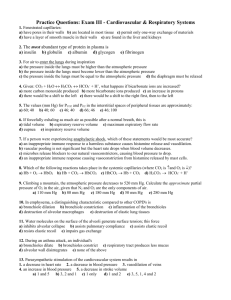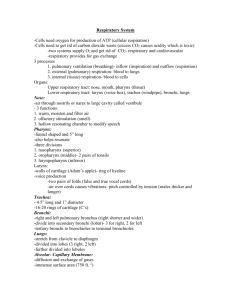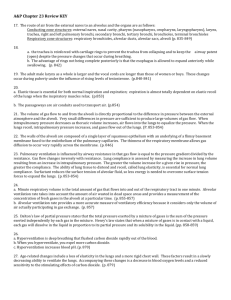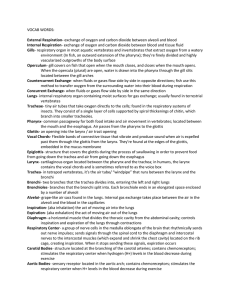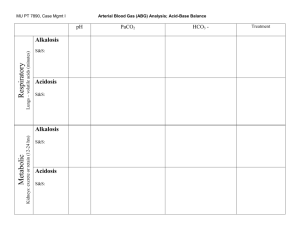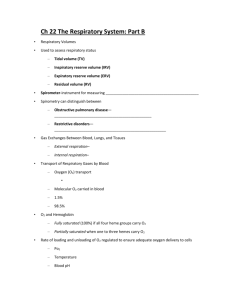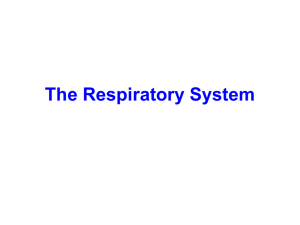Breathing-Exchange-of
advertisement
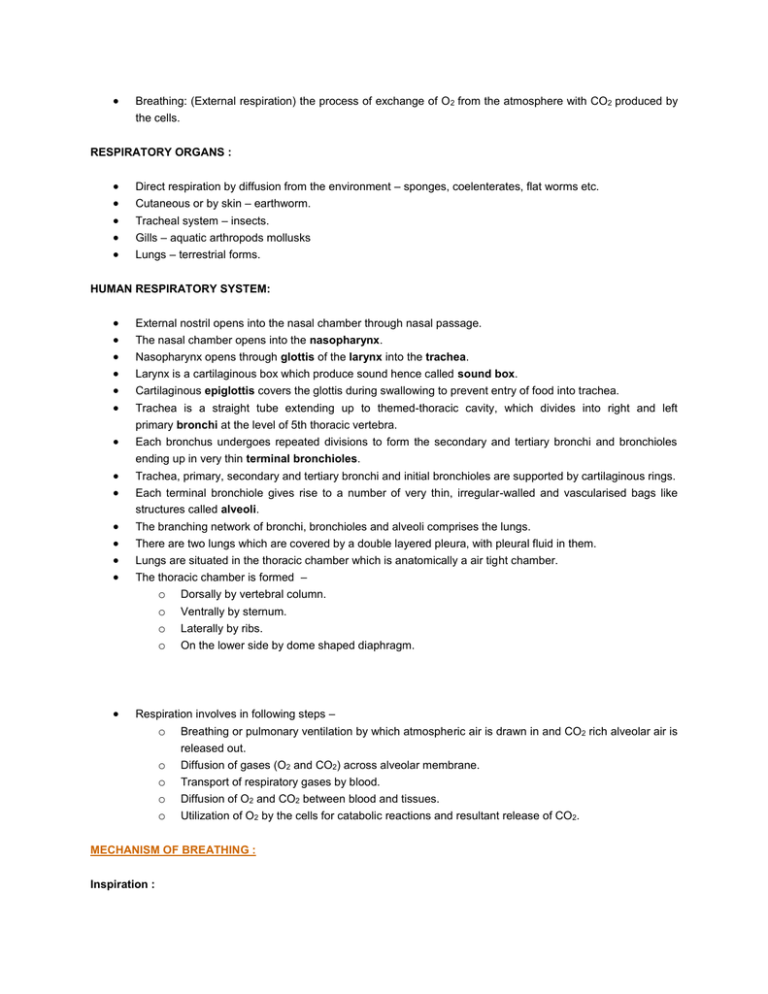
Breathing: (External respiration) the process of exchange of O 2 from the atmosphere with CO2 produced by the cells. RESPIRATORY ORGANS : Direct respiration by diffusion from the environment – sponges, coelenterates, flat worms etc. Cutaneous or by skin – earthworm. Tracheal system – insects. Gills – aquatic arthropods mollusks Lungs – terrestrial forms. HUMAN RESPIRATORY SYSTEM: External nostril opens into the nasal chamber through nasal passage. The nasal chamber opens into the nasopharynx. Nasopharynx opens through glottis of the larynx into the trachea. Each bronchus undergoes repeated divisions to form the secondary and tertiary bronchi and bronchioles ending up in very thin terminal bronchioles. Trachea, primary, secondary and tertiary bronchi and initial bronchioles are supported by cartilaginous rings. Each terminal bronchiole gives rise to a number of very thin, irregular-walled and vascularised bags like structures called alveoli. The branching network of bronchi, bronchioles and alveoli comprises the lungs. Larynx is a cartilaginous box which produce sound hence called sound box. Cartilaginous epiglottis covers the glottis during swallowing to prevent entry of food into trachea. Trachea is a straight tube extending up to themed-thoracic cavity, which divides into right and left primary bronchi at the level of 5th thoracic vertebra. There are two lungs which are covered by a double layered pleura, with pleural fluid in them. Lungs are situated in the thoracic chamber which is anatomically a air tight chamber. The thoracic chamber is formed – o Dorsally by vertebral column. o o o Ventrally by sternum. Laterally by ribs. On the lower side by dome shaped diaphragm. Respiration involves in following steps – o Breathing or pulmonary ventilation by which atmospheric air is drawn in and CO2 rich alveolar air is released out. o o o o Diffusion of gases (O2 and CO2) across alveolar membrane. Transport of respiratory gases by blood. Diffusion of O2 and CO2 between blood and tissues. Utilization of O2 by the cells for catabolic reactions and resultant release of CO2. MECHANISM OF BREATHING : Inspiration : Intake of atmospheric air into the lungs. It causes an increase in pulmonary volume decrease the intra-pulmonary pressure to less than the atmospheric pressure. It forces the air out side to move in to the lungs, i.e, inspiration. It occurs if the pressure within the lungs (intra-pulmonary pressure) is lower than the atmospheric pressure. Contraction of diaphragm which increases the volume of thoracic chamber in the anterior posterior axis. The contraction of external intercostals muscles lifts up the ribs and the sternum causing an increase in the volume of thoracic chamber in the dorso ventral axis. Expiration : Relaxation of diaphragm and inter-costal muscles returns the diaphragm and sternum to their normal positions and reduce the thoracic and pulmonary volume. It increases in intrapulmonary pressure slightly above the atmospheric pressure. It causes the expulsion of air from the lungs, i.e, expiration. A healthy man breathes 12-16 times/minutes. The volume of air involved in breathing is estimated by spirometer. Respiratory Volumes and Capacities : Tidal volume: volume of air inspired or expired during a normal breathing. It is about 500 ml. Inspiratory reserve volume: Additional volume of air, a person inspire by a forceful inspiration. It is about 2500-3000 ml. Expiratory reserve volume: Additional volume of air, a person expires by a forceful expiration. It is about 1000-1100 ml. Residual volume: Volume of air remaining in the lungs even after a forceful expiration. It is about 1200 ml. Inspiratory capacity: it includes tidal volume and Inspiratory reserve volume. Expiratory capacity: it includes tidal volume and expiratory reserve volume. Functional residual capacity: This includes ERV+RV. Vital capacity: IRV + TV + ERV. Total lung capacity: RV + IRV + TV + ERV EXCHANGE OF GASES : Alveoli are the primary site of exchange of respiratory gases. Exchange of gases also takes place between blood and tissues. Exchange of O2 and CO2 take place in the pressure gradient, by simple diffusion. Pressure contributed by an individual gas in a mixture of gases is called the partial pressure and is represented by pO2 for oxygen and pCO2 for carbon dioxide. Diffusion of O2 o o o pO2 in alveolar air = 104 mm Hg. pO2 in venous blood = 40 mm Hg. O2 diffuses from alveoli to venous blood. Diffusion of CO2 o o o pCO2 is venous blood = 45 mm Hg. pCO2 is alveolar air = 40 mm Hg CO2 diffuses from venous blood to alveoli. Solubility of CO2 is 20-25 times higher than that of O2; the amount of CO2 that can diffuse through the diffusion membrane per unit difference in partial pressure is much higher compared to that of O 2. Respiratory membrane is formed by; o o o Thin Squamous epithelium of the alveoli. Endothelium of alveolar capillaries Basement membrane between them. TRANSPORT OF GASES : Blood is the medium of transport of O2 and CO2. About 97 per cent of O2 is transported by RBCs in the blood. 3 per cent of O2 is transported in the plasma in dissolved state. 20-25 per cent of CO2 transported in the RBC in the form of carbamino-haemoglobin. 70 percent CO2 carried as bicarbonate ion in plasma. 7 percent CO2 transported in dissolved state in plasm. Transport of Oxygen : Haemoglobin is red coloured pigment present in the RBC. O2binds with hemoglobin reversibly to form oxy-hemoglobin. Each haemoglobin can binds maximum with four O2 molecules. Binding of Oxygen with haemoglobin is primarily related with partial pressure of O 2. Partial pressure of CO2, hydrogen ion concentration (pH) and temperature are the factors that influence this binding. A sigmoid curve is obtained when percentage of saturation of hemoglobin with O 2 is plotted against the partial pressure of O2 (pO2). This curve is called oxygen dissociation curve. Condition favourable for binding of Hemoglobin with O2 at alveolar level; o o o High pO2 Low H+ ion concentration. Low temperature. Condition favourable for dissociation of HbO2 into Hb and O2 at tissue level; o Low pO2 o o High H+ ion concentration. High temperature. Every 100 ml of oxygenated blood can deliver around 5 ml of O 2 to the tissues under normal physiological conditions. Transport of Carbon dioxide: 20-25 percent of CO2 is carried out in the RBC by binding with the free amino group of haemoblobin by formation of carbamino-haemoglobin. When pCO2 is high and pO2 is low as in the tissues, more binding of CO2 occurs whereas, when the pCO2 is low and pO2 is high as in the alveoli, dissociation of CO2 from carbamino-haemoglobin takes place. 70 per cent of CO2 transported in the form of HCO3- in the plasma. CO2 from the tissue diffused into the plasma and along with the water it forms carbonic acid which dissociated into HCO3- and H+. This reaction is catalysed by an enzyme called carbonic anhydrase present in the plasma membrane of RBC and plasma. REGULATION OF RESPIRATION : Specialized centre present in the medulla region of the brain called respiratory rhythm centre is primarily responsible for regulation of breathing. Pneumotaxis centre of pons region of brain has moderate regulation. Neural signal from this centre can reduce the duration of inspiration and alter the rate of respiration. Chemosensitive area adjacent to rhythm centre is sensitive to CO2 and H+ ion. Receptors associated with aortic arch and carotid artery also can recognize changes in the CO 2 and H+ concentration and send necessary signals to the rhythm centre for remedial actions. DISORDERS OF REPIRATORY SYSTEM : Asthma : is a difficulty in breathing causing wheezing due to inflammation of bronchi and bronchioles. Emphysema : a chronic disorder in which alveolar walls are damaged due to which respiratory surface is decreased. It caused due to smoking.
